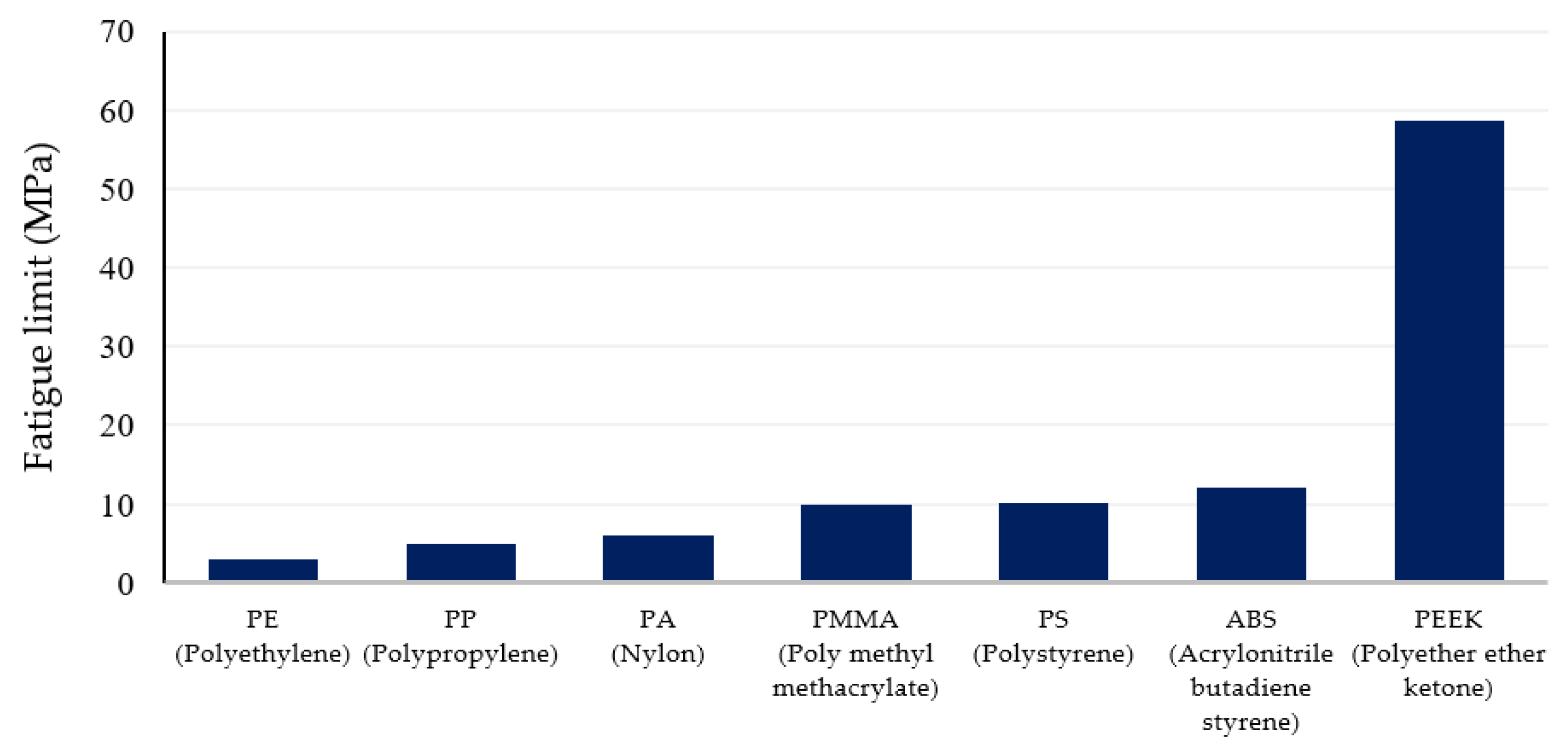Effect of 3D Printing Parameters on the Fatigue Properties of Parts Manufactured by Fused Filament Fabrication: A Review
Abstract
1. Introduction
2. Three-Dimensional Printing Parameters
3. Fatigue in Polymers and FFF Prints
Fatigue Testing of Polymers
4. Influence of 3D Printing Parameters on the Fatigue Life of FFF Prints
4.1. Raster Angle
4.2. Infill Pattern
4.3. Infill Density
4.4. Layer Height
4.5. Nozzle Diameter
4.6. Nozzle Temperature
4.7. Printing Speed
4.8. Build Orientation
5. Summary
6. Conclusions
- How do strain rates and the loading frequency influence the fatigue life of FFF prints?
- How do FFF prints behave when subjected to a random or combined fatigue loading?
- How and to what extent do the temperature, environment, and surface finish impact the fatigue performance of FFF parts?
- The fatigue behaviour of composite FFF prints is in the initial stage and needs further investigation.
- In some applications, such as biomedical implants, a low infill density is required for tissue growth and osteoinduction. Thus, a compromise between infill density and fatigue strength should be made when an FFF print is used in such applications.
- The efficacy of other infill patterns, such as hexagonal and honeycomb, on the fatigue performance of FFF prints can be studied as they have shown great potential under static loading.
- Due to the anisotropic nature and layered configurations of FFF prints, they do not fully comply with the existing standards for the fatigue testing of polymers. Thus, new standards need to be developed.
Author Contributions
Funding
Institutional Review Board Statement
Informed Consent Statement
Data Availability Statement
Conflicts of Interest
References
- Khorasani, M.; Ghasemi, A.; Rolfe, B.; Gibson, I. Additive manufacturing a powerful tool for the aerospace industry. Rapid Prototyp. J. 2021, 27, 87–100. [Google Scholar] [CrossRef]
- Vasco, J.C. Additive manufacturing for the automotive industry. In Additive Manufacturing; Elsevier: Amsterdam, The Netherlands, 2021; pp. 505–530. [Google Scholar]
- Lai, J.; Wang, C.; Wang, M. 3D printing in biomedical engineering: Processes, materials, and applications. Appl. Phys. Rev. 2021, 8, 021322. [Google Scholar] [CrossRef]
- Ali, M.H.; Issayev, G.; Shehab, E.; Sarfraz, S. A critical review of 3D printing and digital manufacturing in construction engineering. Rapid Prototyp. J. 2022, 28, 1312–1324. [Google Scholar] [CrossRef]
- Lipton, J.I.; Cutler, M.; Nigl, F.; Cohen, D.; Lipson, H. Additive manufacturing for the food industry. Trends Food Sci. Technol. 2015, 43, 114–123. [Google Scholar] [CrossRef]
- Vafadar, A.; Guzzomi, F.; Rassau, A.; Hayward, K. Advances in metal additive manufacturing: A review of common processes, industrial applications, and current challenges. Appl. Sci. 2021, 11, 1213. [Google Scholar]
- Lindemann, C.; Reiher, T.; Jahnke, U.; Koch, R. Towards a sustainable and economic selection of part candidates for additive manufacturing. Rapid Prototyp. J. 2015, 21, 216–227. [Google Scholar] [CrossRef]
- Gebler, M.; Uiterkamp, A.J.S.; Visser, C. A global sustainability perspective on 3D printing technologies. Energy Policy 2014, 74, 158–167. [Google Scholar]
- Kumar, H.A.; Reginald Elvis, P.F.; Manoharan, M.; Jayapal, J.; Kumaraguru, S. Tailored Support Structures for Additive Manufacturing. In Advances in Additive Manufacturing and Joining; Springer: Berlin/Heidelberg, Germany, 2020; pp. 199–207. [Google Scholar]
- Jiang, J.; Xu, X.; Stringer, J. Support structures for additive manufacturing: A review. J. Manuf. Mater. Process. 2018, 2, 64. [Google Scholar]
- Lazarus, N.; Bedair, S.S.; Hawasli, S.H.; Kim, M.J.; Wiley, B.J.; Smith, G.L. Selective Electroplating for 3D-Printed Electronics. Adv. Mater. Technol. 2019, 4, 1900126. [Google Scholar]
- Boulaala, M.; Elmessaoudi, D.; Buj-Corral, I.; Mesbahi, J.E.; Mazighe, M.; Astito, A.; Mrabet, M.E.; Elmesbahi, A. Reviews of Mechanical Design and Electronic Control of Multi-material/Color FDM 3D Printing. In Proceedings of the International Conference on Integrated Design and Production, Fez, Morocco, 14–16 October 2019; pp. 230–238. [Google Scholar]
- Safai, L.; Cuellar, J.S.; Smit, G.; Zadpoor, A.A. A review of the fatigue behavior of 3D printed polymers. Addit. Manuf. 2019, 28, 87–97. [Google Scholar]
- Puigoriol-Forcada, J.M.; Alsina, A.; Salazar-Martín, A.G.; Gomez-Gras, G.; Pérez, M.A. Flexural fatigue properties of polycarbonate fused-deposition modelling specimens. Mater. Des. 2018, 155, 414–421. [Google Scholar] [CrossRef]
- Padzi, M.; Bazin, M.; Muhamad, W. Fatigue characteristics of 3D printed acrylonitrile butadiene styrene (ABS). In IOP Conference Series: Materials Science and Engineering; IOP Publishing: Bristol, UK, 2017; p. 012060. [Google Scholar]
- Shahar, F.S.; Sultan, M.T.H.; Safri, S.N.A.; Jawaid, M.; Talib, A.R.A.; Basri, A.A.; Shah, A.U.M. Fatigue and impact properties of 3D printed PLA reinforced with kenaf particles. J. Mater. Res. Technol. 2022, 16, 461–470. [Google Scholar] [CrossRef]
- Senatov, F.; Niaza, K.; Stepashkin, A.; Kaloshkin, S. Low-cycle fatigue behavior of 3d-printed PLA-based porous scaffolds. Compos. Part B Eng. 2016, 97, 193–200. [Google Scholar] [CrossRef]
- Travieso-Rodriguez, J.A.; Zandi, M.D.; Jerez-Mesa, R.; Lluma-Fuentes, J. Fatigue behavior of PLA-wood composite manufactured by fused filament fabrication. J. Mater. Res. Technol. 2020, 9, 8507–8516. [Google Scholar] [CrossRef]
- Miller, A.T.; Safranski, D.L.; Smith, K.E.; Sycks, D.G.; Guldberg, R.E.; Gall, K. Fatigue of injection molded and 3D printed polycarbonate urethane in solution. Polymer 2017, 108, 121–134. [Google Scholar] [CrossRef]
- Arbeiter, F.; Spoerk, M.; Wiener, J.; Gosch, A.; Pinter, G. Fracture mechanical characterization and lifetime estimation of near-homogeneous components produced by fused filament fabrication. Polym. Test. 2018, 66, 105–113. [Google Scholar] [CrossRef]
- Jiang, C.-P.; Cheng, Y.-C.; Lin, H.-W.; Chang, Y.-L.; Pasang, T.; Lee, S.-Y. Optimization of FDM 3D printing parameters for high strength PEEK using the Taguchi method and experimental validation. Rapid Prototyp. J. 2022, 28, 1260–1271. [Google Scholar] [CrossRef]
- Gordelier, T.J.; Thies, P.R.; Turner, L.; Johanning, L. Optimising the FDM additive manufacturing process to achieve maximum tensile strength: A state-of-the-art review. Rapid Prototyp. J. 2019, 25, 953–971. [Google Scholar] [CrossRef]
- Shanmugam, V.; Das, O.; Babu, K.; Marimuthu, U.; Veerasimman, A.; Johnson, D.J.; Neisiany, R.E.; Hedenqvist, M.S.; Ramakrishna, S.; Berto, F. Fatigue behaviour of FDM-3D printed polymers, polymeric composites and architected cellular materials. Int. J. Fatigue 2021, 143, 106007. [Google Scholar]
- Jap, N.S.; Pearce, G.M.; Hellier, A.K.; Russell, N.; Parr, W.C.; Walsh, W.R. The effect of raster orientation on the static and fatigue properties of filament deposited ABS polymer. Int. J. Fatigue 2019, 124, 328–337. [Google Scholar] [CrossRef]
- Baş, H.; Elevli, S.; Yapıcı, F. Fault tree analysis for fused filament fabrication type three-dimensional printers. J. Fail. Anal. Prev. 2019, 19, 1389–1400. [Google Scholar] [CrossRef]
- Masood, S.H. Advances in fused deposition modeling. In Comprehensive Materials Processing; Elsevier: Amsterdam, The Netherlands, 2014. [Google Scholar]
- Janssen, R.P.; de Kanter, D.; Govaert, L.E.; Meijer, H.E. Fatigue life predictions for glassy polymers: A constitutive approach. Macromolecules 2008, 41, 2520–2530. [Google Scholar] [CrossRef]
- Abood, A.; Saleh, A.; Ali, A.; Humood, L. Low Cycle Fatigue of Different Polymer Types PA, PVC, and POM. J. Mech. Eng. 2011, 38, 4154–4156. [Google Scholar]
- Hoyt, A.J.; Yakacki, C.M.; Fertig III, R.S.; Carpenter, R.D.; Frick, C.P. Monotonic and cyclic loading behavior of porous scaffolds made from poly (para-phenylene) for orthopedic applications. J. Mech. Behav. Biomed. Mater. 2015, 41, 136–148. [Google Scholar] [CrossRef]
- Fred-Ahmadu, O.H.; Bhagwat, G.; Oluyoye, I.; Benson, N.U.; Ayejuyo, O.O.; Palanisami, T. Interaction of chemical contaminants with microplastics: Principles and perspectives. Sci. Total Environ. 2020, 706, 135978. [Google Scholar] [CrossRef]
- Bafandeh, M.R.; Mojarrabian, H.M.; Doostmohammadi, A. Poly (vinyl alcohol)/chitosan/akermanite nanofibrous scaffolds prepared by electrospinning. J. Macromol. Sci. Part B 2019, 58, 749–759. [Google Scholar] [CrossRef]
- Tang, S.; Cheang, P.; AbuBakar, M.; Khor, K.; Liao, K. Tension–tension fatigue behavior of hydroxyapatite reinforced polyetheretherketone composites. Int. J. Fatigue 2004, 26, 49–57. [Google Scholar] [CrossRef]
- Mura, A.; Ricci, A.; Canavese, G. Investigation of fatigue behavior of ABS and PC-ABS polymers at different temperatures. Materials 2018, 11, 1818. [Google Scholar] [CrossRef]
- Pruitt, L. Fatigue Testing and Behavior of Plastics; ASM International: Materials Park, OH, USA, 2000; pp. 758–767. [Google Scholar]
- He, F.; Khan, M. Effects of printing parameters on the fatigue behaviour of 3D-printed ABS under dynamic thermo-mechanical loads. Polymers 2021, 13, 2362. [Google Scholar] [CrossRef]
- Fischer, M.; Schöppner, V. Fatigue behavior of FDM parts manufactured with Ultem 9085. Jom 2017, 69, 563–568. [Google Scholar] [CrossRef]
- Afrose, M.F.; Masood, S.; Iovenitti, P.; Nikzad, M.; Sbarski, I. Effects of part build orientations on fatigue behaviour of FDM-processed PLA material. Prog. Addit. Manuf. 2016, 1, 21–28. [Google Scholar] [CrossRef]
- Baptista, R.; Guedes, M. Porosity and pore design influence on fatigue behavior of 3D printed scaffolds for trabecular bone replacement. J. Mech. Behav. Biomed. Mater. 2021, 117, 104378. [Google Scholar] [CrossRef] [PubMed]
- Jiang, D.; Ning, F.; Wang, Y. Additive manufacturing of biodegradable iron-based particle reinforced polylactic acid composite scaffolds for tissue engineering. J. Mater. Process. Technol. 2021, 289, 116952. [Google Scholar] [CrossRef]
- ASTM D7774-12; Standard Test Method for Flexural Fatigue Properties of Plastics. ASTM International: West Conshohocken, PA, USA, 2012.
- ASTM D3479; Standard Test Method for Tension-Tension Fatigue of Polymer Matrix Composite Materials. ASTM International: West Conshohocken, PA, USA, 2012.
- ASTM D7791-12; Standard Test Method for Uniaxial Fatigue Properties of Plastics. ASTM International: West Conshohocken, PA, USA, 2017.
- ISO 13003:2003; Fibre-Reinforced Plastics—Determination of Fatigue Properties under Cyclic Loading Conditions. ISO: Geneva, Switzerland, 2003.
- ASTM D6115-97; Standard Test Method for Mode I Fatigue Delamination Growth Onset of Unidirectional Fiber-Reinforced Polymer Matrix Composites. ASTM International: West Conshohocken, PA, USA, 2011.
- ISO 15850:2014; Plastics—Determination of Tension-Tension Fatigue Crack Propagation—Linear Elastic Fracture Mechanics (LEFM) Approach. ISO: Geneva, Switzerland, 2014.
- ASTM E739-91; Standard Practice for Statistical Analysis of Linear or Linearized Stress-Life (SN) and Strain-Life (ε-N) Fatigue Data. ASTM International: West Conshohocken, PA, USA, 2015.
- ASTM E606; Standard Practice for Strain-Controlled Fatigue Testing. ASTM International: West Conshohocken, PA, USA, 1998; Volume 3.
- ASTM D4482-11; Standard Test Method for Rubber Property—Extension Cycling Fatigue. ASTM International: West Conshohocken, PA, USA, 2017.
- ASTM D671-93; Standard Test Method for Flexural Fatigue of Plastics by Constant-Amplitude-of-Force (Withdrawn 2002). ASTM International: West Conshohocken, PA, USA, 1993.
- Forster, A.M.; Forster, A.M. Materials testing standards for additive manufacturing of polymer materials: State of the art and standards applicability. In Additive Manufacturing Materials; Elsevier: Amsterdam, The Netherlands, 2015. [Google Scholar]
- Callister, W.D., Jr.; Rethwisch, D.G. Callister’s Materials Science and Engineering; John Wiley & Sons: Hoboken, NJ, USA, 2020. [Google Scholar]
- Brčić, M.; Kršćanski, S.; Brnić, J. Rotating Bending Fatigue Analysis of Printed Specimens from Assorted Polymer Materials. Polymers 2021, 13, 1020. [Google Scholar] [CrossRef] [PubMed]
- Lee, J.; Huang, A. Fatigue analysis of FDM materials. Rapid Prototyp. J. 2013, 19, 291–299. [Google Scholar] [CrossRef]
- Ahn, S.H.; Montero, M.; Odell, D.; Roundy, S.; Wright, P.K. Anisotropic material properties of fused deposition modeling ABS. Rapid Prototyp. J. 2002, 8, 248–257. [Google Scholar] [CrossRef]
- Ziemian, S.; Okwara, M.; Ziemian, C.W. Tensile and fatigue behavior of layered acrylonitrile butadiene styrene. Rapid Prototyp. J. 2015, 21, 270–278. [Google Scholar] [CrossRef]
- Ziemian, C.; Cipoletti, D.; Ziemian, S.; Okwara, M.; Haile, K. Monotonic and cyclic tensile properties of ABS components fabricated by additive manufacturing. In Proceedings of the 2014 International Solid Freeform Fabrication Symposium, Austin, TX, USA, 4–6 August 2014. [Google Scholar]
- Ziemian, C.W.; Ziemian, R.D.; Haile, K.V. Characterization of stiffness degradation caused by fatigue damage of additive manufactured parts. Mater. Des. 2016, 109, 209–218. [Google Scholar] [CrossRef]
- Ziemian, C.; Sharma, M.; Ziemian, S. Anisotropic mechanical properties of ABS parts fabricated by fused deposition modelling. Mech. Eng. 2012, 23, 159–180. [Google Scholar]
- Letcher, T.; Waytashek, M. Material property testing of 3D-printed specimen in PLA on an entry-level 3D printer. In Proceedings of the ASME International Mechanical Engineering Congress and Exposition, Montreal, QC, Canada, 14–20 November 2014; p. V02AT02A014. [Google Scholar]
- Dolzyk, G.; Jung, S. Tensile and fatigue analysis of 3D-printed polyethylene terephthalate glycol. J. Fail. Anal. Prev. 2019, 19, 511–518. [Google Scholar] [CrossRef]
- Baptista, R.; Guedes, M. Fatigue behavior of different geometry scaffolds for bone replacement. Procedia Struct. Integr. 2019, 17, 539–546. [Google Scholar] [CrossRef]
- Liang, X.; Gao, J.; Xu, W.; Wang, X.; Shen, Y.; Tang, J.; Cui, S.; Yang, X.; Liu, Q.; Yu, L. Structural mechanics of 3D-printed poly (lactic acid) scaffolds with tetragonal, hexagonal and wheel-like designs. Biofabrication 2019, 11, 035009. [Google Scholar] [CrossRef] [PubMed]
- Gong, B.; Cui, S.; Zhao, Y.; Sun, Y.; Ding, Q. Strain-controlled fatigue behaviors of porous PLA-based scaffolds by 3D-printing technology. J. Biomater. Sci. Polym. Ed. 2017, 28, 2196–2204. [Google Scholar] [CrossRef]
- Domingo-Espin, M.; Travieso-Rodriguez, J.A.; Jerez-Mesa, R.; Lluma-Fuentes, J. Fatigue performance of ABS specimens obtained by fused filament fabrication. Materials 2018, 11, 2521. [Google Scholar] [CrossRef] [PubMed]
- Dadashi, A.; Azadi, M. Experimental bending fatigue data of additive-manufactured PLA biomaterial fabricated by different 3D printing parameters. Preprints 2022, 2022010252. [Google Scholar] [CrossRef]
- Jerez-Mesa, R.; Travieso-Rodriguez, J.A.; Llumà-Fuentes, J.; Gomez-Gras, G.; Puig, D. Fatigue lifespan study of PLA parts obtained by additive manufacturing. Procedia Manuf. 2017, 13, 872–879. [Google Scholar] [CrossRef]
- Gomez-Gras, G.; Jerez-Mesa, R.; Travieso-Rodriguez, J.A.; Lluma-Fuentes, J. Fatigue performance of fused filament fabrication PLA specimens. Mater. Des. 2018, 140, 278–285. [Google Scholar] [CrossRef]
- Azadi, M.; Dadashi, A.; Dezianian, S.; Kianifar, M.; Torkaman, S.; Chiyani, M. High-cycle bending fatigue properties of additive-manufactured ABS and PLA polymers fabricated by fused deposition modeling 3D-printing. Forces Mech. 2021, 3, 100016. [Google Scholar] [CrossRef]
- Corbett, T.; Kok, T.; Lee, C.; Tarbutton, J. Identification of mechanical and fatigue characteristics of polymers fabricated by additive manufacturing process. In Proceedings of the 2014 ASPE Spring Topical Meeting, Berkeley, CA, USA, 13–16 April 2014; Volume 57, pp. 186–189. [Google Scholar]
- Gurrala, P.K.; Regalla, S.P. Part strength evolution with bonding between filaments in fused deposition modelling: This paper studies how coalescence of filaments contributes to the strength of final FDM part. Virtual Phys. Prototyp. 2014, 9, 141–149. [Google Scholar] [CrossRef]
- Gray, R.W.; Baird, D.G.; Bøhn, J.H. Effects of processing conditions on short TLCP fiber reinforced FDM parts. Rapid Prototyp. J. 1998, 4, 14–25. [Google Scholar] [CrossRef]
- Zhong, W.; Li, F.; Zhang, Z.; Song, L.; Li, Z. Short fiber reinforced composites for fused deposition modeling. Mater. Sci. Eng. A 2001, 301, 125–130. [Google Scholar] [CrossRef]
- Sood, A.K.; Ohdar, R.K.; Mahapatra, S.S. Parametric appraisal of mechanical property of fused deposition modelling processed parts. Mater. Des. 2010, 31, 287–295. [Google Scholar] [CrossRef]
- Singh, R. Process capability analysis of fused deposition modelling for plastic components. Rapid Prototyp. J. 2014, 20, 69–76. [Google Scholar] [CrossRef]
- Ezeh, O.; Susmel, L. Fatigue strength of additively manufactured polylactide (PLA): Effect of raster angle and non-zero mean stresses. Int. J. Fatigue 2019, 126, 319–326. [Google Scholar] [CrossRef]
- Ezeh, O.; Susmel, L. On the fatigue strength of 3D-printed polylactide (PLA). Procedia Struct. Integr. 2018, 9, 29–36. [Google Scholar] [CrossRef]
- Akhouri, D.; Karmakar, D.; Banerjee, D.; Mishra, S. Various Infill Patterns and their Effect in 3D Printable Materials. Int. J. Innov. Sci. Res. Technol. 2021, 6, 538–542. [Google Scholar]
- Miller, A.T.; Safranski, D.L.; Wood, C.; Guldberg, R.E.; Gall, K. Deformation and fatigue of tough 3D printed elastomer scaffolds processed by fused deposition modeling and continuous liquid interface production. J. Mech. Behav. Biomed. Mater. 2017, 75, 1–13. [Google Scholar] [CrossRef]
- Salmoria, G.; Hotza, D.; Klauss, P.; Kanis, L.; Roesler, C. Manufacturing of porous polycaprolactone prepared with different particle sizes and infrared laser sintering conditions: Microstructure and mechanical properties. Adv. Mech. Eng. 2014, 6, 640496. [Google Scholar] [CrossRef]
- Mikos, A.G.; Sarakinos, G.; Lyman, M.D.; Ingber, D.E.; Vacanti, J.P.; Langer, R. Prevascularization of porous biodegradable polymers. Biotechnol. Bioeng. 1993, 42, 716–723. [Google Scholar] [CrossRef]
- Garzon-Hernandez, S.; Garcia-Gonzalez, D.; Jérusalem, A.; Arias, A. Design of FDM 3D printed polymers: An experimental-modelling methodology for the prediction of mechanical properties. Mater. Des. 2020, 188, 108414. [Google Scholar] [CrossRef]
- Tymrak, B.; Kreiger, M.; Pearce, J.M. Mechanical properties of components fabricated with open-source 3-D printers under realistic environmental conditions. Mater. Des. 2014, 58, 242–246. [Google Scholar] [CrossRef]
- Wang, T.-M.; Xi, J.-T.; Jin, Y. A model research for prototype warp deformation in the FDM process. Int. J. Adv. Manuf. Technol. 2007, 33, 1087–1096. [Google Scholar] [CrossRef]
- Travieso-Rodriguez, J.A.; Jerez-Mesa, R.; Llumà, J.; Traver-Ramos, O.; Gomez-Gras, G.; Roa Rovira, J.J. Mechanical properties of 3D-printing polylactic acid parts subjected to bending stress and fatigue testing. Materials 2019, 12, 3859. [Google Scholar] [CrossRef] [PubMed]
- Triyono, J.; Sukanto, H.; Saputra, R.M.; Smaradhana, D.F. The effect of nozzle hole diameter of 3D printing on porosity and tensile strength parts using polylactic acid material. Open Eng. 2020, 10, 762–768. [Google Scholar] [CrossRef]
- Yang, L.; Li, S.; Li, Y.; Yang, M.; Yuan, Q. Experimental investigations for optimizing the extrusion parameters on FDM PLA printed parts. J. Mater. Eng. Perform. 2019, 28, 169–182. [Google Scholar] [CrossRef]
- Kiński, W.; Pietkiewicz, P. Influence of the printing nozzle diameter on tensile strength of produced 3D models in FDM technology. Agric. Eng. 2020, 24, 31–38. [Google Scholar] [CrossRef]
- Miazio, Ł. Impact of print speed on strength of samples printed in FDM technology. Agric. Eng. 2019, 23, 33–38. [Google Scholar] [CrossRef]
- Calafel, I.; Aguirresarobe, R.; Peñas, M.; Santamaria, A.; Tierno, M.; Conde, J.; Pascual, B. Searching for rheological conditions for FFF 3D printing with PVC based flexible compounds. Materials 2020, 13, 178. [Google Scholar] [CrossRef]
- Bellini, A.; Güçeri, S. Mechanical characterization of parts fabricated using fused deposition modeling. Rapid Prototyp. J. 2003, 9, 252–264. [Google Scholar] [CrossRef]
- Domingo-Espin, M.; Puigoriol-Forcada, J.M.; Garcia-Granada, A.-A.; Llumà, J.; Borros, S.; Reyes, G. Mechanical property characterization and simulation of fused deposition modeling Polycarbonate parts. Mater. Des. 2015, 83, 670–677. [Google Scholar] [CrossRef]
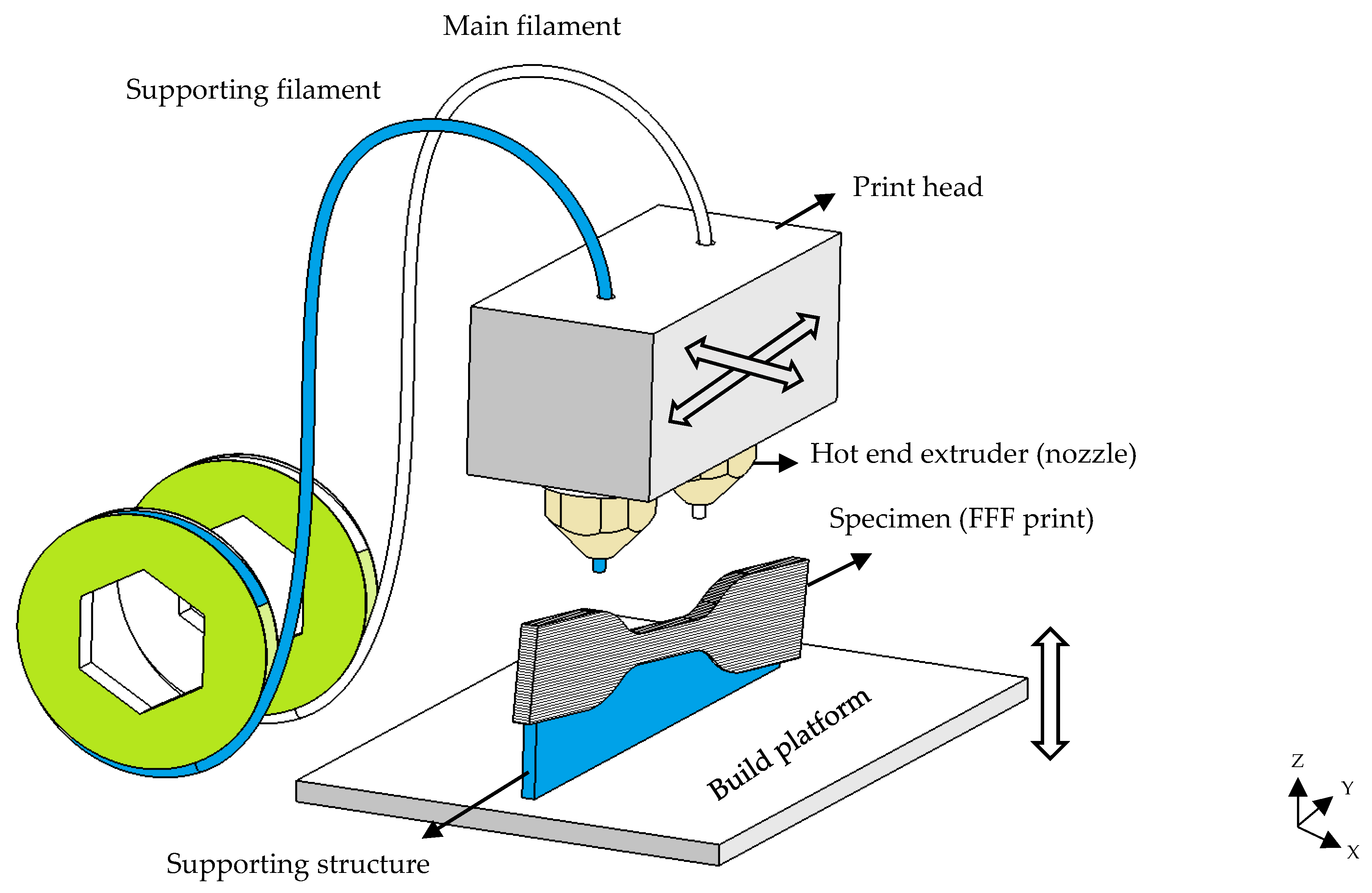

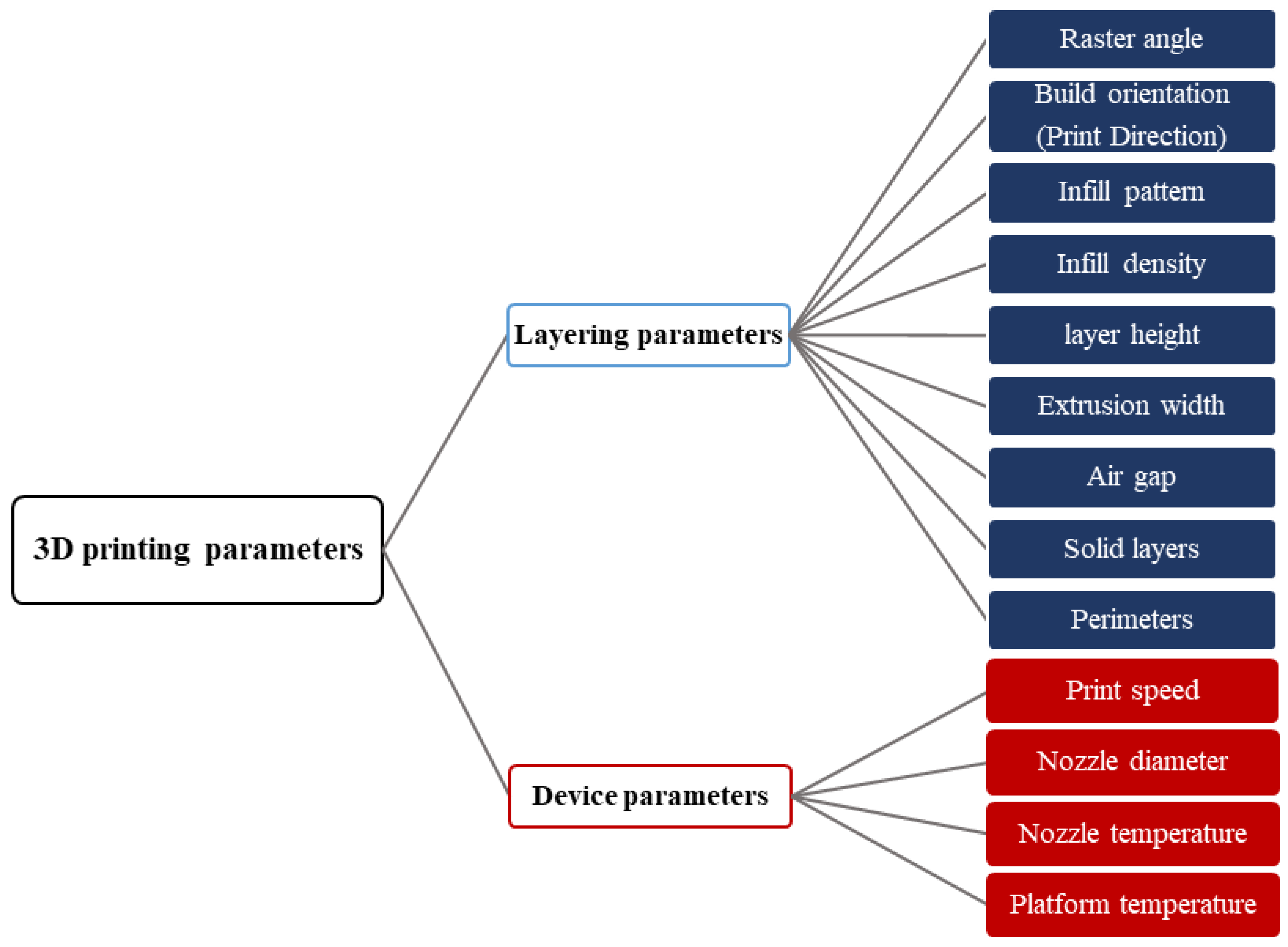
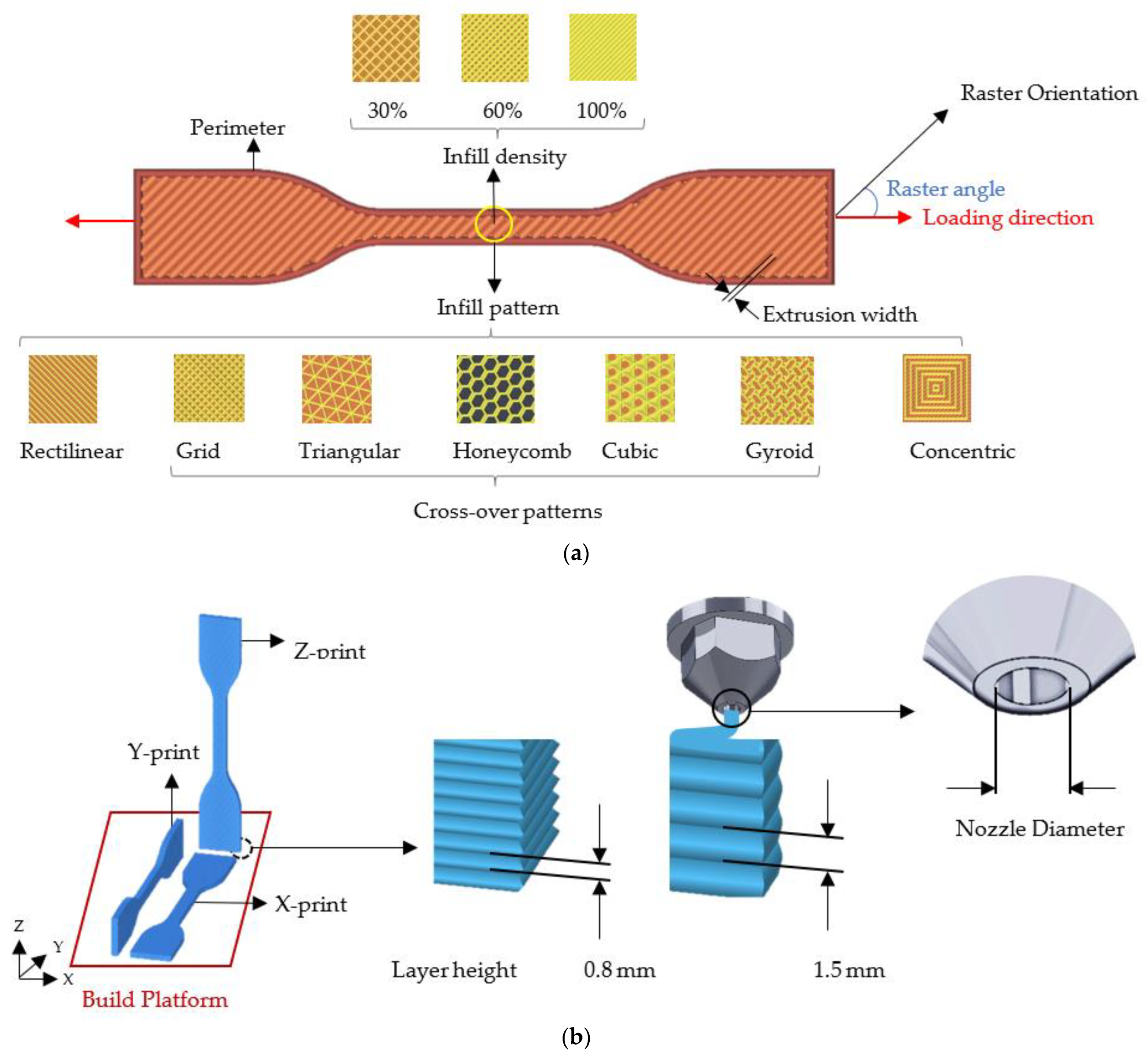
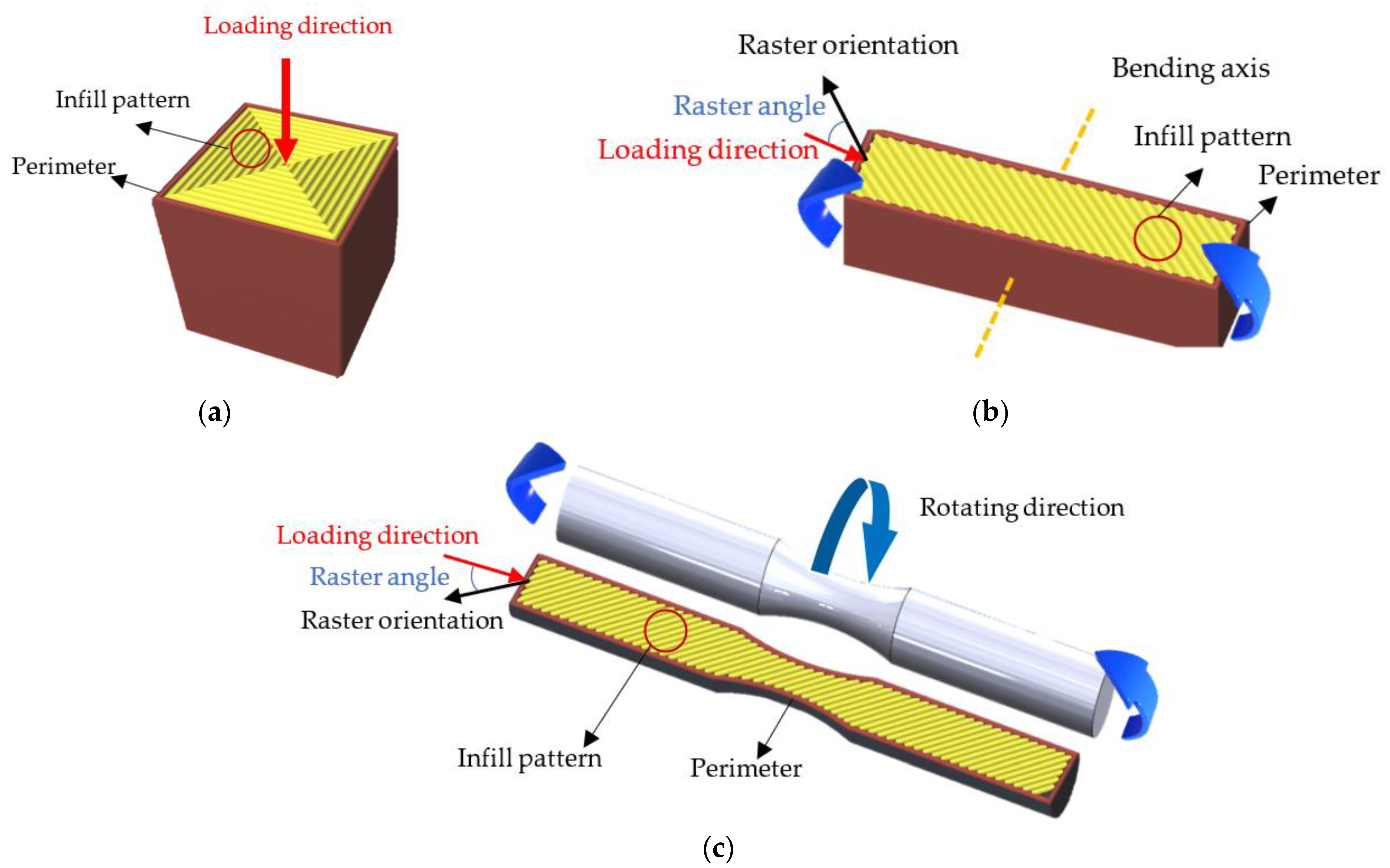
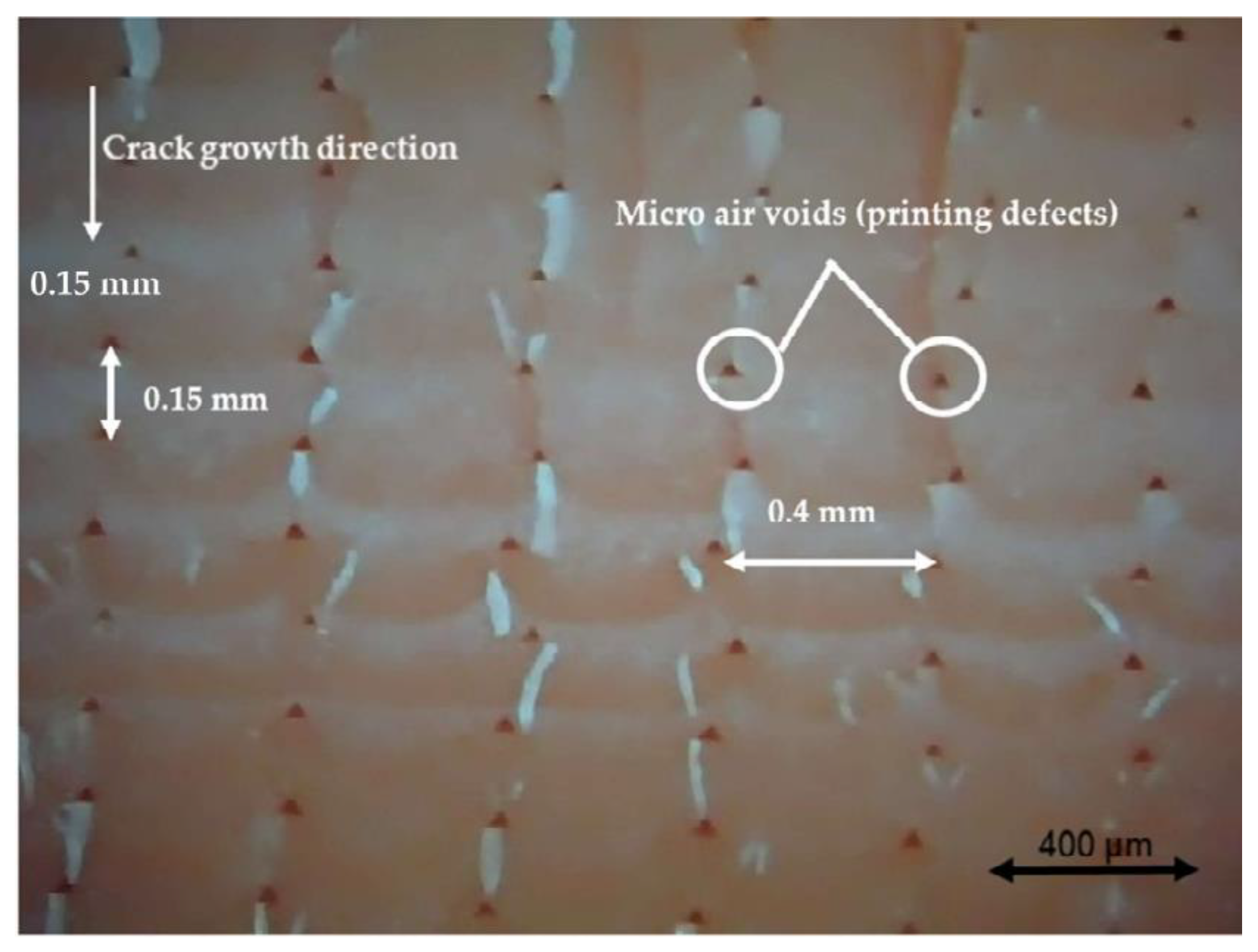


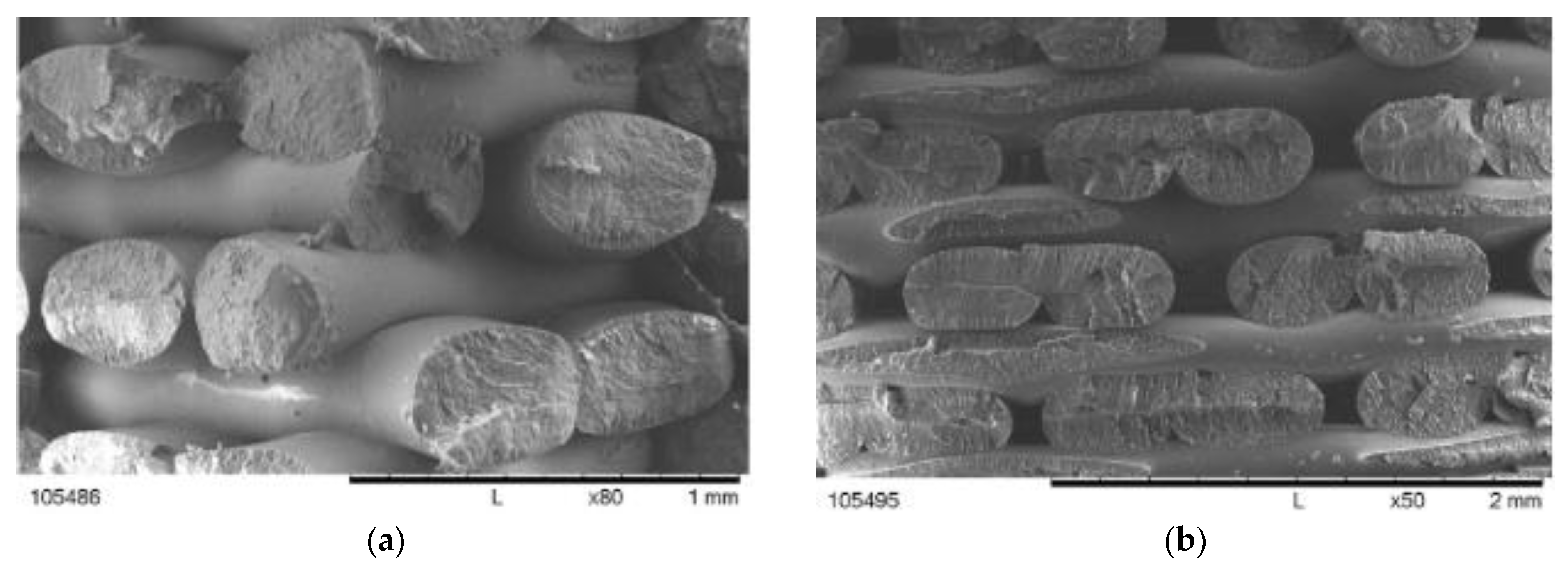
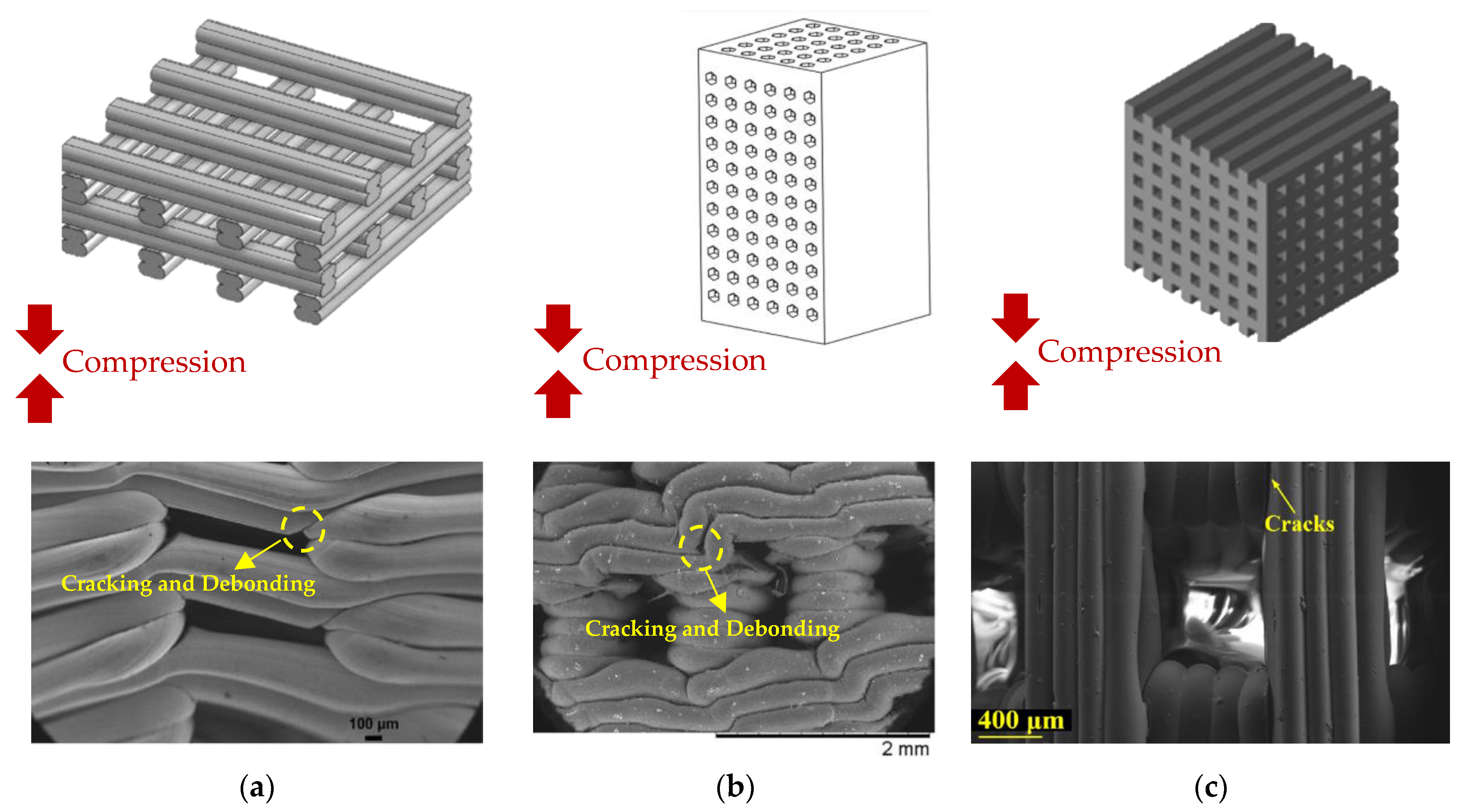


| Standard | Application | Ref. |
|---|---|---|
| ASTM D7774 | Flexural fatigue of plastics | [40] |
| ASTM D3479 | Tension–tension fatigue of polymer matrix composites | [41] |
| ASTM D7791 | Uniaxial (tension or compression) fatigue of plastics | [42] |
| ISO 13003 | Fatigue properties of fibre-reinforced plastics | [43] |
| ASTM D6115 | Crack propagation of fibre-reinforced polymer composites under fatigue (Mode I) | [44] |
| ISO 15850 | Tension–tension fatigue crack propagation | [45] |
| ASTM E739 | Statistical analysis of linear or linearized stress–life (S–N) and strain–life (ε–N) fatigue data | [46] |
| ASTM E606 | Strain-controlled fatigue testing | [47] |
| ASTM D4482 | Tensile (extension) fatigue of rubber compounds | [48] |
| Type | Mat | Variable Parameters *a | Fixed Parameters *a | Specimen Standard | Testing Conditions | Results | Ref |
|---|---|---|---|---|---|---|---|
| Tensile | ABS | Build orientation: X, Y, Z Raster angle: 0, 45, 90° | FFF printer: Stratasys Dimension | ISO 527-1 | Loading type: stress controlled Stress level: 40, 60, 80% UTS Loading frequency: loading (25.4 mm/min) + unloading (12.7 mm/min) Cycles: up to 10,000 | Fatigue performance (at similar stress): Y prints > X and Z prints All raster angles produced relatively similar fatigue resistance (0° prints performed slightly better). | [53] |
| Infill pattern: grid (0/90°), grid (−45/45°) | Infill density: 100% FFF printer: Stratasys UPrint SE™ | ISO 527-2 | Loading type: stress controlled Stress level: 40, 60, 80, 90% UTS Loading frequency: 5 Hz | Fatigue life (at same stress): grid (–45°/45°) > grid (0°/90°) Fatigue life (at same % of UTS): grid (0/90°) ≈ grid (−45/45°) | [24] | ||
| Raster angle: 0, 45, 90° Infill pattern: rectilinear, grid (45/−45°) | Nozzle T: 320 °C Platform T: 80 °C Layer H: 0.1778 mm Extrusion W: 0.3048 mm Infill density: 100% FFF printer: Stratasys Vantage-i | ASTM-D638 | Loading type: Stress controlled Stress level: 45%, 60%, 75%, 90% UTS, R = 0.1 (triangular wave) Loading frequency: 0.25 Hz Cycles: up to 25 h (or ~175,200 cycles) | Fatigue life (at similar % UTS): grid (45°/−45°) > rectilinear (0°) > rectilinear (45°) > rectilinear (90°) | [55,56] | ||
| Raster angle: 0, 45, 90° Infill pattern: rectilinear, grid (0/−90°), grid (15/−75°), grid (30/−60°), grid (45/−45°) | Air gap: 0 mm Extrusion W: 0.3048 mm Layer H: 0.1778 mm Infill density: 100% FFF printer: Stratasys Vantage-i | ASTM-D638 | Loading type: stress controlled Stress level: 45, 60, 75, 90% UTS, R = 0.1 (triangular wave), Loading frequency: 0.25 Hz Cycles: up to 25h (~17,500 cycles) | Fatigue performance: grid (45/−45°) > grid (30/−60°) > grid (15/−75°) > grid (0/−90°) > rectilinear (0°) > rectilinear (45°) > rectilinear (90°) | [57] | ||
| Raster angle: 0, 45, 90° Infill pattern: rectilinear, grid (45/−45°) | Build orientation: X Nozzle T: 320 °C Air gap: 0 mm Extrusion W: 0.3048 mm Layer H: 0.1778 mm Infill density: 100% FFF printer: Stratasys Vantage-i | ASTM-D3479 | Loading type: stress controlled Stress level: 70% UTS, R = 0.1 Loading frequency: 0.25 Hz | Fatigue performance: grid (45/−45°) > rectilinear (0°) > rectilinear (90°) > rectilinear (45°) | [58] | ||
| Manufacturing method: FFF, injection moulding (IM) | - | ASTM-D638 | Loading type: stress controlled Stress level: 40, 60, and 80% UTS, R = 0 Loading frequency: 1 Hz | Fatigue life: IM parts > FFF parts (~41% lower fatigue life) | [15] | ||
| PLA | Raster angle: 0, 45, 90° | Nozzle D: 0.2 mm Infill density: 100% FFF printer: Cube-2 | ASTM-D638 | Loading type: stress controlled Stress level: 50, 60, 70, 80 % UTS Loading frequency: 1 Hz Cycles: up to 5000 cycles | Fatigue life (at same % of UTS): 45° print > 90° print> 0° print | [37] | |
| Raster angle: 0, 90° Infill pattern: rectilinear, grid (0/90°) | Print T: 250 °C Platform T: 70 °C Nozzle D: 0.5 mm Layer H: 0.25 mm Print V: 80 mm/s FFF printer: Hage 3DpA2 | ASTM-D5045-99 | Loading type: stress controlled Stress level: R = 0.1 (sinusoidal wave) | Fatigue performance: rectilinear (0°) ≈ rectilinear (90°) ≈ grid (0/90°) Due to good layer adhesion, high nozzle T, and optimum printing parameters, similar results were achieved for all samples (isotropic properties). | [20] | ||
| Raster angle: 0, 45, 90° | Print T: 230 °C Platform T: 65 °C Print V: 100 mm/s Infill density: 100%f FFF printer: MakerBot Replicator 2x | ASTM-D638 | Loading type: stress controlled Stress level: R = -1 (sinusoidal wave) Loading frequency and cycles: 2 Hz up to 1000 cycles, then 5 Hz up to 10,000 cycles, then 20 Hz until failure (max: 1 million cycles) | Fatigue life: 45° print > 0° print >> 90° Endurance limit: 45° print (10 MPa) and 0° print (5 MPa) >> 90° (0.5 MPa) | [59] | ||
| Ultem 9085 | Build orientation: X, Y, Z | Layer H: 0.254 mm FFF printer: Stratasys Fortus 400 mc | ASTM D638 | Loading type: stress controlled Loading frequency: 5 Hz Cycles: until failure or 2 million cycles | Fatigue life: X print ≈ Y print > Z Print | [36] | |
| PCU | Manufacturing method: FFF, injection moulding (IM) | Layer H: 0.15 mm Extrusion W: 0.3 mm Nozzle D: 0.5 mm Nozzle T: 225 °C Platform T: 40 °C Print V: 7.5–9 mm/s Infill density: 100% Infill pattern: rectilinear (45°) Perimeters: 3 Build orientation: X FFF printer: Lulzbot TAZ 5 | Custom shape dog-bone (using ASTM-E606 and ASTM-D4482) | Loading type: stress controlled Loading frequency: 5 Hz Environment: PBS bath Cycles: until failure or 1 million cycles | Fatigue performance: FFF parts ≈ IM parts (FFF > IM in some cases) The fracture surfaces of FFF and IM samples were similar. | [19] | |
| PETG | Raster angle: 0, 45, 90° Infill pattern: rectilinear, grid (45/−45°) | Layer H: 0.2 mm Extrusion W: 0.35 mm Nozzle T: 265 °C Platform T: 107 °C Air gap: 0 mm Print V: 40 mm/s Infill density: 100% FFF printer: Ultimaker 3 | ASTM D638 | Loading type: stress controlled Stress level: 60, 70, 80, and 90% UTS, R = 0.1, (sinusoidal wave) Loading frequency and cycles: at 1 Hz up to 10,000 cycles, then at 2 Hz until failure | Fatigue performance: 0° print > 45/−45° print > 45° and 90° prints (at high stresses) 45° print > 0° print > 45/−45° print > 90° print (at low stresses) | [60] | |
| Compressive | PLA | Infill pattern: grid (0/90°), hexagonal (0°/60°/120°) Infill density: 30%, 50%, 70% | Nozzle D: 0.4 mm Nozzle T: 215 °C Print V: 30 mm/s Layer H: 0.2 mm FFF printer: Blocks Zero (Blocktec) | Cube (ASTM D695, 12.7 × 12.7 × 25.4 mm3) | Loading type: stress controlled Stress level: 9–14.5 MPa, R = 0.1 Loading frequency: 0.25 Hz Max. cycles: 3600 Environment: dry | Fatigue performance: grid (0/90°) > hexagonal (0°/60°/120°) Effect of infill density: prints with 50% and 70% infill density resisted fatigue even after 3600 cycles, but 30% infill prints failed at early stages. | [38,61] |
| Infill pattern: grid (0/90°), hexagonal (0°/60°/120°), concentric radial (wheel like) | Nozzle D: 0.2 mm Nozzle T: 230 °C Print V: 90 mm/s Layer H: 0.2 mm FFF printer: MakerBot Replicator 2 | Cylindrical (Ø = 12 mm, height = 12 mm) | Loading type: stress controlled Loading frequency: 1 Hz Stress level: 18 to 180 N (sinusoidal wave) Max. cycles: 10,000 Environment: submerged in PBS | Fatigue life: grid (4400 cycles) > hexagonal (3200 cycles) > concentric radial (2500 cycles) Hysteresis area (damping effect): grid > hexagonal > concentric radial | [62] | ||
| Infill pattern: circular, triangular | Nozzle D: 0.4 mm Infill density: 40% FFF printer: HORI Z500D | Cube (33 × 33 × 33 mm3) | Loading type: strain controlled Loading frequency: 0.2 Hz Strain level: 0.7–3% Strain ratio: 0.5 Max. cycles: 10,000 Environment: dry | Fatigue performance: circular pore pattern > triangular pattern Fatigue damage mechanism: rapid inelastic strain accumulation at initial cycles (~600 cycles), followed by stabilizing over the residual fatigue life | [63] | ||
| Rotating bending | ABS | Layer H: 0.1, 0.2, 0.3 mm Nozzle D: 0.3, 0.4, 0.5 mm Infill density: 25, 50, 75% Print V: 25, 30, 35 mm/sec Infill pattern: rectilinear, honeycomb | Nozzle T: 230 °C Platform T: 100 °C Raster angle:45 Perimeters: 2 Solid layers: 3 layers at bottom FFF printer: Pyramid dual extruder M® | ASTM-D7774 | Loading type: stress controlled Stress level: 8–11.5 N (~28.7–41.2 MPa; sinusoidal wave) | Fatigue performance: honeycomb > rectilinear Influence on fatigue performance: infill density > layer h x nozzle D (print speed and other interactions: not influential) | [64] |
| PLA | Nozzle D: 0.2, 0.4, 0.6 mm Nozzle T: 180, 210, 240 °C Print V: 5, 10, 15 mm/s | Layer H: 0.2 mm Perimeter: 2 Solid layers: 1 at top, 1 at bottom Infill pattern: rectangular Platform T:30 °C Build orientation: horizontal Infill density: 60% | ISO-1143 | Loading type: stress controlled Stress level: 5, 10, 15, 20 MPa Loading frequency: 100 Hz | Influence of parameters on fatigue performance *b: nozzle T (-), nozzle D (-), print V (-) | [65] | |
| Layer H: 0.1, 0.2, 0.3 mm Nozzle D: 0.3, 0.4, 0.5 mm Infill density: 25, 50, 75% Print V: 25, 30, 35 mm/s | Nozzle T: 200 °C Infill pattern: honeycomb | Loading type: stress controlled Stress level: 15N force (~bending stress: 53.8 MPa) Loading frequency: 2800 rev/min | Influence of parameters on fatigue performance *b: infill density (+) > layer H (+) > nozzle D (+) Print V had no significant effect. | [66] | |||
| Layer H: 0.1, 0.2, 0.3 mm Nozzle D: 0.3, 0.4, 0.5 mm Infill density: 25, 50, 75% Printing speed: 25, 30, 35 mm/sec Infill patterns: rectilinear, honeycomb | Perimeters: 2 Solid layers: 3 layers at bottom FFF printer: Prusa i3 Steel 3D printer | ASTM-D7774 | Loading type: stress controlled Stress level: 10–22N (~35.8–78.8 MPa; sinusoidal wave) | Fatigue performance: honeycomb > rectilinear Influence on fatigue performance: infill density > nozzle D > layer h (print speed and other interactions: not influential) | [67] | ||
| PLA and ABS | Raster angle: horizontal (0°), vertical (90°) | Layer H: 0.15 Nozzle D: 0.4 Nozzle T: PLA (200 °C), ABS (245 °C) Platform T: 60 °C Infill density: 50% Print V: 60 mm/s Infill pattern: rectilinear FFF printer: Author-M-Pro | ISO-1143 | Loading type: stress controlled Stress level: bending stress 5, 10, 15 MPa (vertical prints) and 5, 10, 15, 20 MPa (horizontal prints) Loading frequency: 100 Hz | Fatigue life: PLA > ABS Horizontal prints > vertical prints | [68] | |
| PLA-8% Wood fibre | Layer H: 0.2, 0.3, 0.4 mm Nozzle D: 0.5, 0.6, 0.7 mm Infill density: 25, 50, 75% Infill pattern: rectilinear, honeycomb Print V: 25, 30, 35 mm/s | Building orientation: X Raster angle: 45° Nozzle T: 180 °C Platform T: 50 °C FFF printer: PYRAMID3D Studio RepRap | ASTM-D7774 | Loading type: stress controlled Stress level: 10N Loading frequency: 2800 rev/min Cycles: until failure | Fatigue life: honeycomb print > rectilinear print Influence of parameters on fatigue performance *b: layer H (+) > nozzle D (+) > infill density (+) (print speed: not influential) | [18] | |
| Flexural | ABS | Raster angle: 0, 90° Feed rate: 2000, 4000 mm/min | Nozzle T: 200 °C Platform T:100 °C | ASTM D7774-12 | ASTM D7774-12 | Fatigue performance: 0° print > 90° print Influence of parameters on fatigue performance *b: feed rate (-) | [69] |
| Raster angle: 0, 45, 90° Nozzle D: 0.4, 0.6, 0.8 mm Layer H: 0.05, 0.1, 0.15 mm | Nozzle T: 245 °C Platform T: 90 °C Infill density: 100% FFF printer: Ultimaker 2+ | Custom shape | Loading type: strain controlled (using shaker) Strain level: 2 mm (sinusoidal wave) Loading frequency: print natural frequency Cycles: until failure | Storage modulus: 0° print > 45° print > 90° print Nozzle D (+), layer H (+) Fatigue performance: 0° print > 45° print > 90° print Influence of parameters on fatigue performance *b: working temperature (-) > building orientation > nozzle D (+) > layer H (+) 50C to 70C → cycles to failure (96500 to 31700) | [35] | ||
| PC | Build orientation: X, Y, Z | Nozzle T: 290 °C Platform T:145 °C Print V:28 mm/s Layer H: 0.254 mm Extrusion W: 0.508 mm Air gap: 0 mm Shells: 1 Infill density:100% Infill pattern: grid (45/−45°) FFF printer: Stratasys Fortus 400 mc | ASTM-D790 and ASTM-D7774 | Loading type: stress controlled Stress level: 20, 40, 60, and 80% UTS, R = 1, 0.5 Loading frequency: 5 Hz | Fatigue performance: Y and X prints > Z print | [14] |
| Correlation with Mechanical Performance Under | |||||
|---|---|---|---|---|---|
| Tensile Fatigue | Flexural Fatigue | Rotating Bending Fatigue | Compressive Fatigue | ||
 |  |  |  | ||
| 3D printing parameters | Raster angle | ↘* [20,37,53,55,57,58,59,60] | ↘ [35,69] | ↘ [68] | |
| Infill pattern | Cross-over > rectilinear [55,57] | Cross-over > rectilinear [18,64,67] | Grid > other patterns [38,61,62] | ||
| Infill density | ↗ [18,64,66,67] | ↗ [38,61] | |||
| Layer height | ↗ [35,84] | ↗ [18,64,66,67] | |||
| Nozzle diameter | ↗ [35] | ▬ [18,64,65,66,67] | |||
| Nozzle temperature | ↘ [65] | ||||
| Printer speed | ↘ [69] | ▬ [18,64,66,67] | |||
| Build orientation | Y > X > Z [36,53] | Y > X > Z [14] | |||
| Extrusion width | |||||
| Perimeters | |||||
| Number of shells | |||||
| Solid layers | |||||
Disclaimer/Publisher’s Note: The statements, opinions and data contained in all publications are solely those of the individual author(s) and contributor(s) and not of MDPI and/or the editor(s). MDPI and/or the editor(s) disclaim responsibility for any injury to people or property resulting from any ideas, methods, instructions or products referred to in the content. |
© 2023 by the authors. Licensee MDPI, Basel, Switzerland. This article is an open access article distributed under the terms and conditions of the Creative Commons Attribution (CC BY) license (https://creativecommons.org/licenses/by/4.0/).
Share and Cite
Bakhtiari, H.; Aamir, M.; Tolouei-Rad, M. Effect of 3D Printing Parameters on the Fatigue Properties of Parts Manufactured by Fused Filament Fabrication: A Review. Appl. Sci. 2023, 13, 904. https://doi.org/10.3390/app13020904
Bakhtiari H, Aamir M, Tolouei-Rad M. Effect of 3D Printing Parameters on the Fatigue Properties of Parts Manufactured by Fused Filament Fabrication: A Review. Applied Sciences. 2023; 13(2):904. https://doi.org/10.3390/app13020904
Chicago/Turabian StyleBakhtiari, Hamed, Muhammad Aamir, and Majid Tolouei-Rad. 2023. "Effect of 3D Printing Parameters on the Fatigue Properties of Parts Manufactured by Fused Filament Fabrication: A Review" Applied Sciences 13, no. 2: 904. https://doi.org/10.3390/app13020904
APA StyleBakhtiari, H., Aamir, M., & Tolouei-Rad, M. (2023). Effect of 3D Printing Parameters on the Fatigue Properties of Parts Manufactured by Fused Filament Fabrication: A Review. Applied Sciences, 13(2), 904. https://doi.org/10.3390/app13020904







